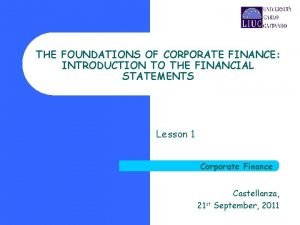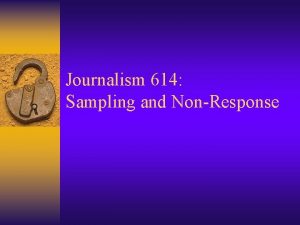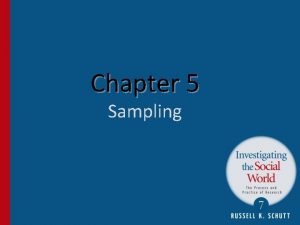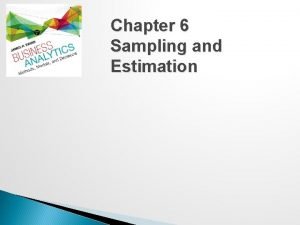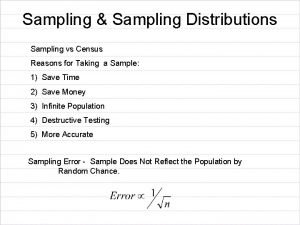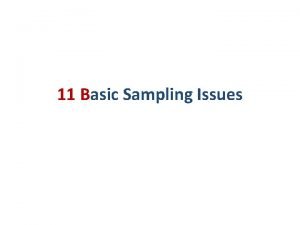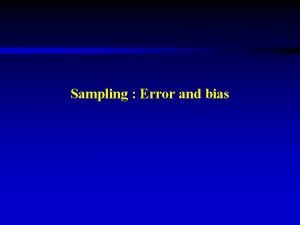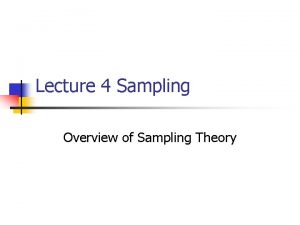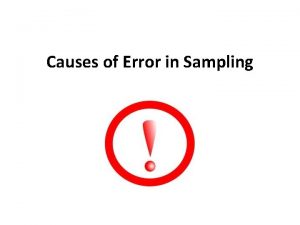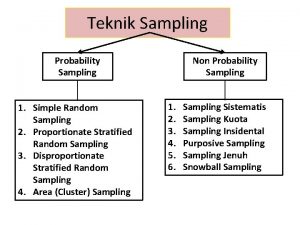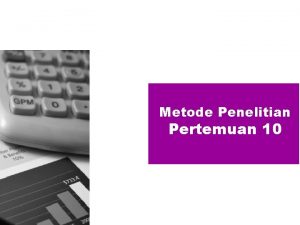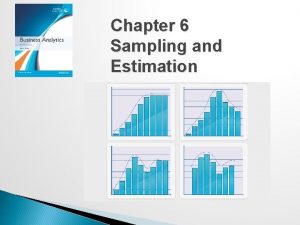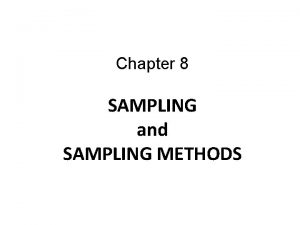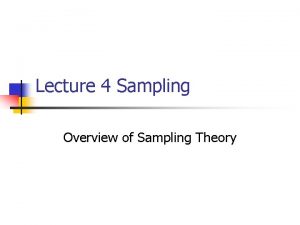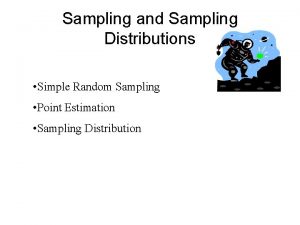Sampling 4 1 Foundations of Sampling Sampling is

























- Slides: 25

Sampling

4. 1 Foundations of Sampling • Sampling is the process of selecting units from a population of interest – Most often people, groups, and organizations, but sometimes texts like diaries, Internet discussion boards and blogs, or even graphic images – By studying the sample, we can generalize results to the population from which the units were chosen

4. 2 Sampling Terminology

4. 2 Sampling Terminology (cont’d. ) • Accessible population – A group you can get access to when sampling, usually contrasted with theoretical population • Bias – A systematic error in an estimate – Can be the result of any factor that leads to an incorrect estimate, and can lead to a result that does not represent the true value in the population

4. 3 External Validity • Generalizing – The process of making an inference that the results observed in a sample would hold in the population of interest – if such an inference or conclusion is valid we can say that it has generalizability • External validity – The degree to which the conclusions in your study would hold for other persons in other places and at other times

4. 3 a Two Major Approaches to External Validity in Sampling: The Sampling Model

4. 3 a Two Major Approaches to External Validity: The Proximal Similarity Model

4. 4 Sampling Methods • Nonprobability sampling – Sampling that does not involve random selection • Probability sampling – Sampling that does involve random selection

4. 5 Nonprobability Sampling • Does not involve random selection – Random selection is a process or procedure that assures that the different units in your population are selected by chance • Two kinds of nonprobability sampling – Accidental – Purposive

4. 5 a Accidental, Haphazard, or Convenience Sampling • Sampling by asking for volunteers • Sampling by using available participants, such as college students • Sampling by interviewing people on the streets • The problem: you do not know if your sample represents the population

4. 5 b Purposive Sampling • Several types: – 4. 5 c Modal Instance Sampling – 4. 5 d Expert Sampling: Validity – 4. 5 e Quota Sampling • Proportional Quota Sampling • Nonproportional Quota Sampling – 4. 5 f Heterogeneity Sampling – 4. 5 g Snowball Sampling: • Respondent Driven Sampling

4. 6 a The Sampling Distribution – Statistical Terms

4. 6 a The Sampling Distribution – A Theoretical Distribution

4. 6 b Sampling Error • Standard Deviation • Standard Error • Sampling Error

4. 6 c The Normal Curve In Sampling

4. 7 Probability Sampling: Procedures • 4. 7 a Definitions: – N is the number of cases in the sampling frame – n is the number of cases in the sample – NCn is the number of combinations (subsets) of n from N – f = n/N is the sampling fraction

4. 7 b Simple Random Sampling

4. 7 c Stratified Random Sampling

4. 7 d Systematic Random Sampling

4. 7 e Cluster (Area) Random Sampling

4. 7 f Multistage Sampling • The combining of several sampling techniques to create a more efficient or effective sample than the use of any one sampling type can achieve on its own

4. 7 g How Big Should the Sample Be? • Bigger is better, as it increases the confidence in results • However, this has to be balanced with cost and time considerations • Sample size is also determined by the sampling technique used

4. 8 Threats to External Validity • Can the results be generalized to other people? • Can the results be generalized to other places? • Can the results be generalized to other time periods?

4. 9 Improving External Validity • Do a good job of drawing a sample from a population – Random selection is always better • Use proximal similarity effectively • Replication – When a study is repeated with a different group of people, in a different place, at a different time, and the results of the study are similar, external validity is increased

Discuss and Debate • What does the term population really mean? What are some examples of populations? • What are the advantages and disadvantages of each sampling technique in this chapter, and when would you choose one technique over another? • What is external validity, and what is the best way to strengthen it?
 Definition of sampling in research
Definition of sampling in research Cluster vs stratified
Cluster vs stratified Natural sampling vs flat top sampling
Natural sampling vs flat top sampling Observasi event sampling
Observasi event sampling Probability sampling vs non probability sampling
Probability sampling vs non probability sampling Cluster vs stratified sampling
Cluster vs stratified sampling Cluster sampling advantages and disadvantages
Cluster sampling advantages and disadvantages Foundations of government vocabulary
Foundations of government vocabulary Foundations of corporate finance
Foundations of corporate finance Chapter 6 lesson 1 foundations of a healthy relationship
Chapter 6 lesson 1 foundations of a healthy relationship Hotel industry analytics
Hotel industry analytics Theoretical foundations of transcultural nursing
Theoretical foundations of transcultural nursing Nonverbal communication
Nonverbal communication Preschool learning foundations volume 1
Preschool learning foundations volume 1 Economic foundations of strategy
Economic foundations of strategy Capuzzi and stauffer
Capuzzi and stauffer Cognitive foundations of entrepreneurship
Cognitive foundations of entrepreneurship Aohs foundations of anatomy and physiology 1
Aohs foundations of anatomy and physiology 1 Foundations of american government unit 1 test review
Foundations of american government unit 1 test review Historical foundations of curriculum
Historical foundations of curriculum Preschool learning foundations
Preschool learning foundations Mathematical foundations of computer graphics and vision
Mathematical foundations of computer graphics and vision Preschool learning foundations volume 3
Preschool learning foundations volume 3 Preschool curriculum framework volume 1
Preschool curriculum framework volume 1 Human resources foundations wayne cascio videos
Human resources foundations wayne cascio videos Fundamentals of building construction chapter summaries
Fundamentals of building construction chapter summaries








